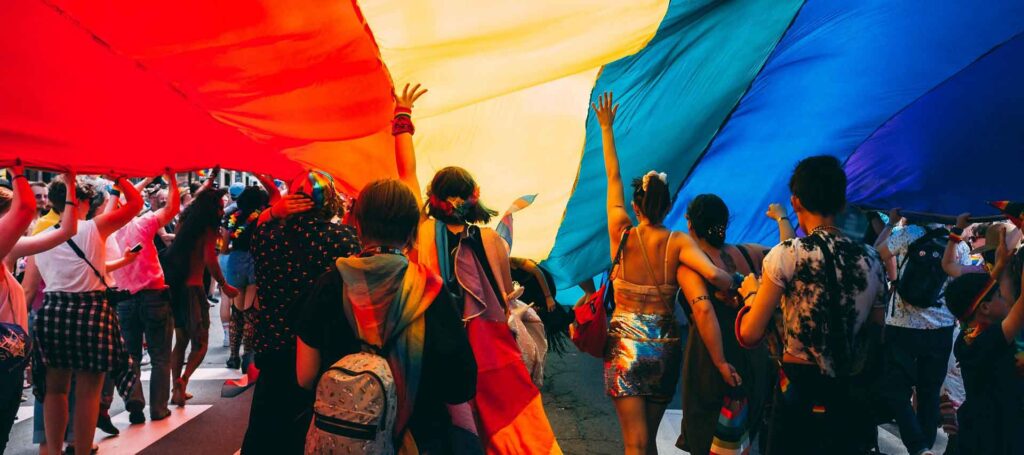Pride month is already behind us. A month dedicated to all that is wonderful and diverse in the LGBTQ+ community went as quickly as it came. Happily, rainbow flags flew at full mast and celebratory events happened where COVID restrictions allowed. As marketers, we couldn’t help but wonder what some people felt about marketing during this time. Today, we look at how to take pride in your marketing and be inclusive.
For many in the north west, the next big date is Manchester Pride from 27-31 August.
Pride and why it is important
June is the month dedicated to LGBTQ+ communities all around the world and it coincided with the historic Stonewall protests in the US. Ultimately, Pride month is about celebration, bringing people together, promoting acceptance and friendship. However, it is also a time to remind people of the work to do on LGBTQ+ rights.
For businesses and communities alike, there is a lot to love about Pride. Diverse points of view, equality and inclusion, motivated teams, happy communities and individuals. We also need to remember how lucky the people are who walk down the street without fear, judgement or harassment. Everyone is entitled to this privilege.
For marketers, what does this mean?
Pride in your marketing
At best, you have a diverse and inclusive organisation that promotes LGBTQ+ causes. Ideally, you have openly proud members of the LGBTQ+ community in senior positions and support LGBTQ+ charities. Your recruitment practices are designed to reduce bias and ultimately, your marketing is inclusive.
At worst, your organisation has a long way to go to be ‘best in class’. Perhaps your external statements on LGBTQ+ bear no resemblance to the internal experiences of staff. Perhaps the subject isn’t spoken of at all and staff feel they need to hide who they are.
In the best case, marketers have a great opportunity to showcase what an amazing organisation you are. What better marketing and PR is there than when you walk the walk and talk the talk. However, for those in the middle or towards the worst case, flying the rainbow flag for a month could backfire.
A cynical ploy or marketing to be proud of?
We asked a few of our closest friends in the LGBTQ+ community for their opinion on the matter. Some were critical of the ‘short-term focus’ on LGBTQ+ but where the rainbow flag is displayed, they may be more likely to buy. Another commented that Pride marketing requires businesses to ‘back it up’ with support for a LGBTQ+ charity. Some were critical of the motives if they are only chasing the ‘pink pound’.
How often do we see advertising that portrays a ‘typical’ family scene or couples that are only man and woman? The LGBTQ+ community identifies with images of LGBTQ+ couples in advertising. Crucially, one person highlighted a recent advertisement that worked only because they used a real-life couple, not actors.
A common theme for Pride
A key thread across the feedback we received is the need for authenticity. Changing the colours of your logo or using a rainbow banner on your social media profile runs the risk of appearing cynical. Whilst it may give you a short-term boost in sales, it may only be short-term. The LGBTQ+ community wants to see real action and to understand what an organisation is like. They also want to feel identified with the images, people and causes that your organisation promotes.
We asked what brands they identify with but in general they suggested that ‘normal stereotypes’ dominate marketing material. True success in LGBTQ+, diversity and inclusion come when we don’t think anything about seeing LGBTQ+ people in an advert and it is just the norm.

More to do for marketers and organisations for Pride marketing
Cutting to the chase, there is work to do. There are also opportunities for marketers in future. We couldn’t find many examples of personalisation or targeting of campaigns to the LGBTQ+ community. Interestingly, our friends agreed that they are happy to have campaigns that target and identify with their community.
However, we were cautioned that this needs a ‘root and branch’ culture that supports diversity and inclusion to pull it off. This is because the products the LGBTQ+ community buys are the same as anyone else would buy. The problems arise with customer experience where people make assumptions that are ignorant of how people identify or partner. Ultimately, this creates an awkwardness rather than the positive emotions that campaigns hope to elicit.
Think Beyond and taking pride in your marketing
Like anything in life, a job done properly gets better results. Opportunistic and insincere attempts to capture ‘the pink pound’ are seen as such. Worse still, when a service makes your customers feel negative emotions, whether you are in the LGBTQ+ community or not, it harms long-term sales.
This is one area where market research and neuroscience could help inclusivity. Many things fall into the ‘doing’ category in marketing but Pride and LGBTQ+ are more than a ‘tick box’ exercise. We can use research to understand how people feel and respond to your brand, campaigns and your experience. In summary, there are no excuses for cynical and short-term approaches.
If you would like to discuss diversity and inclusion in your marketing, simply email hello@think-beyond.co.uk.
Alternatively, if you have any other questions, simply enter a few bits of information into our form.
Finally, why not check some of our other thoughts on what matters to people of all communities.

